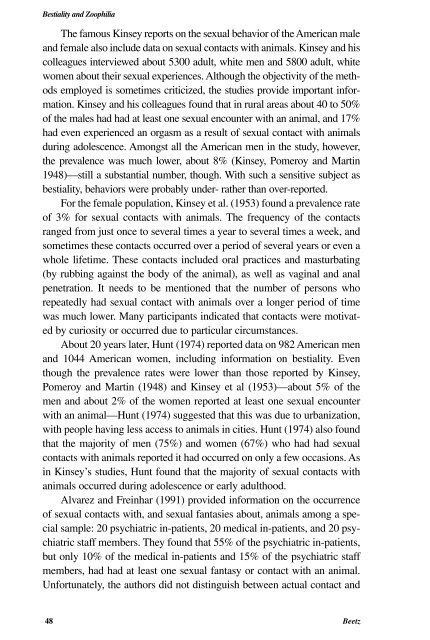Bestiality and zoophilia - Evolve For Animals
Bestiality and zoophilia - Evolve For Animals
Bestiality and zoophilia - Evolve For Animals
Create successful ePaper yourself
Turn your PDF publications into a flip-book with our unique Google optimized e-Paper software.
<strong>Bestiality</strong> <strong>and</strong> ZoophiliaThe famous Kinsey reports on the sexual behavior of the American male<strong>and</strong> female also include data on sexual contacts with animals. Kinsey <strong>and</strong> hiscolleagues interviewed about 5300 adult, white men <strong>and</strong> 5800 adult, whitewomen about their sexual experiences. Although the objectivity of the methodsemployed is sometimes criticized, the studies provide important information.Kinsey <strong>and</strong> his colleagues found that in rural areas about 40 to 50%of the males had had at least one sexual encounter with an animal, <strong>and</strong> 17%had even experienced an orgasm as a result of sexual contact with animalsduring adolescence. Amongst all the American men in the study, however,the prevalence was much lower, about 8% (Kinsey, Pomeroy <strong>and</strong> Martin1948)—still a substantial number, though. With such a sensitive subject asbestiality, behaviors were probably under- rather than over-reported.<strong>For</strong> the female population, Kinsey et al. (1953) found a prevalence rateof 3% for sexual contacts with animals. The frequency of the contactsranged from just once to several times a year to several times a week, <strong>and</strong>sometimes these contacts occurred over a period of several years or even awhole lifetime. These contacts included oral practices <strong>and</strong> masturbating(by rubbing against the body of the animal), as well as vaginal <strong>and</strong> analpenetration. It needs to be mentioned that the number of persons whorepeatedly had sexual contact with animals over a longer period of timewas much lower. Many participants indicated that contacts were motivatedby curiosity or occurred due to particular circumstances.About 20 years later, Hunt (1974) reported data on 982 American men<strong>and</strong> 1044 American women, including information on bestiality. Eventhough the prevalence rates were lower than those reported by Kinsey,Pomeroy <strong>and</strong> Martin (1948) <strong>and</strong> Kinsey et al (1953)—about 5% of themen <strong>and</strong> about 2% of the women reported at least one sexual encounterwith an animal—Hunt (1974) suggested that this was due to urbanization,with people having less access to animals in cities. Hunt (1974) also foundthat the majority of men (75%) <strong>and</strong> women (67%) who had had sexualcontacts with animals reported it had occurred on only a few occasions. Asin Kinsey’s studies, Hunt found that the majority of sexual contacts withanimals occurred during adolescence or early adulthood.Alvarez <strong>and</strong> Freinhar (1991) provided information on the occurrenceof sexual contacts with, <strong>and</strong> sexual fantasies about, animals among a specialsample: 20 psychiatric in-patients, 20 medical in-patients, <strong>and</strong> 20 psychiatricstaff members. They found that 55% of the psychiatric in-patients,but only 10% of the medical in-patients <strong>and</strong> 15% of the psychiatric staffmembers, had had at least one sexual fantasy or contact with an animal.Unfortunately, the authors did not distinguish between actual contact <strong>and</strong>48 Beetz


